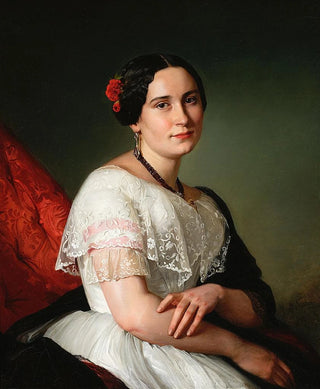Art print | Portrait of the artist's sister Katarzyna Jahn - Józef Simmler


View from behind

Frame (optional)
Captivating introduction
In the art world, some works transcend their era and capture the very essence of human relationships. The art print of the artist Katarzyna Jahn's sister by Józef Simmler is a perfect example. This painting, imbued with delicacy and emotional depth, immerses us in the artist's intimate universe and invites us to explore the subtleties of family bonds. Through the piercing gaze of the sister, we feel a tangible connection, as if she were revealing secrets hidden in the silence of the canvases. Every brushstroke seems to tell a story, that of a shared life, fraternal love, and an artistic quest.
Style and uniqueness of the work
Józef Simmler's style is distinguished by a subtle harmony between realism and romanticism. In this piece, Katarzyna's features are delicately rendered, each detail of her face bearing witness to meticulous attention. Simmler excels at capturing not only physical appearance but also the soul of his subject. Light plays a crucial role, enveloping the sister's figure in a soft, melancholic atmosphere, creating a sense of depth and volume. The colors, carefully chosen, evoke a palette of feelings, oscillating between tenderness and nostalgia. This art print does not merely depict a person; it immortalizes an emotion, a frozen moment in time where beauty and vulnerability meet.
The artist and his influence
Józef Simmler, an emblematic figure of his time, managed to establish himself through an innovative style that combines tradition and modernity. Born into a rich artistic context, he was influenced by the great masters of the past while developing a unique voice. His ability to observe and render the human in all its complexity marked his contemporaries and continues to inspire many artists today. Simmler does not just paint; he tells stories, evokes memories, and builds bridges between generations. His work, notably this portrait of his sister, bears witness to an era when art was not only a form of expression but also a means of

Matte finish

View from behind

Frame (optional)
Captivating introduction
In the art world, some works transcend their era and capture the very essence of human relationships. The art print of the artist Katarzyna Jahn's sister by Józef Simmler is a perfect example. This painting, imbued with delicacy and emotional depth, immerses us in the artist's intimate universe and invites us to explore the subtleties of family bonds. Through the piercing gaze of the sister, we feel a tangible connection, as if she were revealing secrets hidden in the silence of the canvases. Every brushstroke seems to tell a story, that of a shared life, fraternal love, and an artistic quest.
Style and uniqueness of the work
Józef Simmler's style is distinguished by a subtle harmony between realism and romanticism. In this piece, Katarzyna's features are delicately rendered, each detail of her face bearing witness to meticulous attention. Simmler excels at capturing not only physical appearance but also the soul of his subject. Light plays a crucial role, enveloping the sister's figure in a soft, melancholic atmosphere, creating a sense of depth and volume. The colors, carefully chosen, evoke a palette of feelings, oscillating between tenderness and nostalgia. This art print does not merely depict a person; it immortalizes an emotion, a frozen moment in time where beauty and vulnerability meet.
The artist and his influence
Józef Simmler, an emblematic figure of his time, managed to establish himself through an innovative style that combines tradition and modernity. Born into a rich artistic context, he was influenced by the great masters of the past while developing a unique voice. His ability to observe and render the human in all its complexity marked his contemporaries and continues to inspire many artists today. Simmler does not just paint; he tells stories, evokes memories, and builds bridges between generations. His work, notably this portrait of his sister, bears witness to an era when art was not only a form of expression but also a means of






